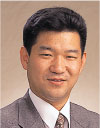|
|
 |
|
|
Mathematical Foundation of Computer Science Laboratory |

Hidesada Kanda
Professor |

Nobuyoshi Asai
Assistant Professor |
|
We conduct researchworks extensively related to the fundamental theories and advanced applications of mathematics, especially in numerical computation.
Prof. Kanda moved to Mathematical Foundation of Computer Science Lab in April, 2002. His research interests are mainly in numerical analysis of partial differential equations, and emphasis is placed on the development of program codes for Navier-Stokes Equation in complex-shaped flow fields. Differential geometry, tensor analysis, and grid generation are also studied as needed. In 2002, he succeeded in the calculation of the minimum critical Reynolds number of 1230 for transition from laminar to turbulent flow between parallel plates for the first time in history.
Prof. Asai's major research fronts may be described as follows:
- Matrix-theoretic high-performance algorithm construction, with application to the numerical computation of critically important quantities associated with difficult special functions occurring from 3-D wave equations, such as regular Coulomb wave functions, Mathieu functions, spheroidal wave functions, Lame functions, ellipsoidal wave functions. The Bessel function of the first kind, an easier function serves as a model case, where two types of computational problems were solved in the complex domain as well as real domain: given a complex order Bessel function, compute a given number of zeros closest to the origin to a specified accuracy; and given a complex number find a specified number of orders of Bessel functions closest to the origin, to a specified accuracy. There are no comparable algorithms known elsewhere which give as accurate an error estimate as ours.
- Construction of hyper English word study dictionary: it is available at http://hidic.u-aizu.ac.jp/. This represents a long-range project, aiming at compiling a database for the study of English words for Japanese students. The main feature is that the dictionary is organized to bring out the best fruits of comparative linguistics in the past century: the usefulness of Indo European roots as presented in the wonderful book by Calvert Watkins, The American Heritage Dictionary of Indo-EuropeanRoots, Second Edition, HoughtonMifflin, 2000. Example: The organizing principle of the dictionary will tell you that the following words are best studied as a group: riddle, garble, crime, decree, discern, secret, hypocrisy (they are all derivatives from the same Indo-European root krei-, meaning "to sieve", indicating that a group of seemingly unrelated words come from the same notion "to sieve"). Another example: the usage of the so-called synonyms "anger, rage and wrath" can be clearly explained by tracing them back to their respective Indo-European root: anger to angh-, meaning painful, rage to rebh-, meaning violent, impetuous, and wrath to wreit-, meaning to turn, twist (anger is akin to angst, angina, rage is akin to rabid, rabies, and wrath is akin to wreath, writhe).
|
| [nasai-01:2002] | Y. Kikuchi D.S. Cai Y. Ikebe Y. Miyazaki, N. Asai. Computation of Multiple Eigenvalues of Infinite Tri-Diagonal Matrices. Math. Comp., 2002.
accepted |
| [nasai-02:2002] | N. Asai Y. MIyazaki Y. Ikebe Y. Ikebe, D. Cai. Technique of Scripting E-learning Contents (for Linear Algebra). Journal of Japan Distance Learning Association, 2002.
accepted |
| Referred Proceeding Papers |
| [nasai-03:2002] | Y. Miyazaki D.S. Cai Y. Ikebe Y. Ikebe, N. Asai. Modular Model Approach to Technical Writing Instructions { The Structuring Technique Can Best Be Learned from Non-Technical Content. In PNC Annual Conference and Joint Meetings, pages 111-114, 2002. |
| [nasai-04:2002] | N. Asai Y. MIyazaki Y. Ikebe Y. Ikebe, D. Cai. Technique of Scripting E-learning Contents (for Linear Algebra). In The Third Annual Meeting of Japan Distance Learning Association, pages 73-78, 2002. |
|